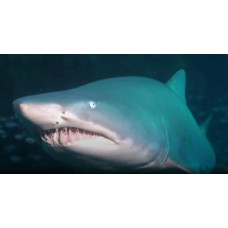Latin name
Ginglymostoma cirratum
Other names
Ginglymostoma cirratum
Identification
When viewed from above or from the side, the head of juvenile sharks is broadly arched, while that of adults is U-shaped. The snout in profile is wedge-shaped, short, and the width of the mouth is 2.3-2.6 times the distance from the premaxilla. Eyes are small, their length is not more than 1% of the body length, they are located dorsolaterally on the head. There are prominent eye ridges below the eyes. The lower edge of the eyes is level with the upper edge of the gill slits. The gill slits are located dorsolaterally on the head and are barely visible from below. The nostrils are located at the tip of the snout. There are thin and elongated cone-shaped nasal antennae, the length of which does not exceed 1% of the body length. They reach the mouth. The lower lip, divided into three lobes by notches, is connected to the mouth by the lower lip furrows. The distance between the lower lip furrows is 1.5 times their length. The teeth do not overlap. Each tooth is equipped with an apex and several lateral denticles, the number of which varies from 2 to 6. The body of adult sharks is covered with large diamond-shaped placoid scales. The total number of vertebrae is 168-175. The number of intestinal valve turns is 16-17.
Features of fish fins
In juvenile sharks, the pectoral fins are broad and narrowly rounded. In adults, they are crescent-shaped. Their bases begin at the level of the third pair of gill slits. The pelvic fins are rounded in juveniles and blunt in adults. The anal fin is considerably smaller than the second dorsal fin, its tip is rounded. The beginning of the base of the anal fin is at the midpoint of the base of the second dorsal fin. The caudal fin is asymmetrical, with the length of the dorsal margin exceeding 25% of the body length. The lower lobe is absent in juveniles and poorly developed in adults. There is a ventral notch on the edge of the upper lobe.
Fish colouring
The coloration is a uniform yellow-brown or gray-brown. The body of juvenile sharks is covered with small dark spots with a light border.
Distribution
They inhabit the Atlantic Ocean and the eastern Pacific Ocean. In the western Atlantic they are found from Rhode Island to southern Brazil, in the eastern Atlantic from Cameroon to Gabon, occasionally in French waters, in the eastern Pacific from southern Baja California to Peru, and in the coastal waters of Caribbean islands.
Habitat
They are found in tropical and subtropical waters on continental and island shelves. They are often found in shallow waters no deeper than 1 m, although they sometimes swim to depths of up to 130 m. They are common inhabitants of reefs, channels connecting mangrove swamps, and sandbanks.
Size
The maximum recorded length is 4.3 meters, but it usually does not exceed 2.5-3 meters.
Behavior
They are nocturnal. During the day they gather in schools of up to 40 individuals and rest on the sandy bottom, in caves or crevices of rocky and coral reefs in shallow waters. Sharks lie close together or even on top of each other. They prefer a particular hiding place once selected and return to the same cave or crevice each day after a night's hunting. They swim at speeds of 31 to 78 cm/sec. They can also crawl along the bottom using their flexible and muscular pectoral fins.
Food and feeding habits
They feed on benthic invertebrates such as crabs, octopuses, sea urchins, mollusks, and small fish such as herring, arias, mullets, parrot fish, surgeon fish, puffer fish, and fluke. Algae are sometimes found in their stomachs, apparently ingested while hunting other prey. The small mouth and pompous shaped throat of sharks allows them to suck in food with great force. Because of their sucking mechanism and nocturnal lifestyle, these sharks can hunt small, active, and agile fish that would easily evade pursuit during the day. When dealing with snails, sharks turn their prey over and suck it out of its shell.
Reproduction
They reproduce by laying eggs. A litter contains 20-30 cubs 27-30 cm long. Pregnancy lasts 5-6 months and females breed every two years. They use shallow waters overgrown with thalassia or covered with coral reefs as natural nurseries. Nurse sharks grow slowly; tagged juveniles of approximately 126 cm in length grew 13 cm per year in the wild. Males and females reach sexual maturity at 10-15 and 15-20 years of age, at lengths of 210 cm and 230 cm, respectively.
Fishing
Not a target fishery, but often caught by local fishermen. Nurse sharks are caught with longlines, gillnets, bottom trawls, bottom seines, and speared. They are sometimes targeted for underwater hunting, but their tough skin makes them difficult prey and the diver risks being bitten.
Relationship with a person
Safe for humans. There have been a few cases of attacks provoked by bathers. The tough skin of these sharks is highly prized and is used to make high quality leather. Meat is eaten fresh and salted, fishmeal is produced. Fat is extracted from the liver.
| Classification | |
| Phylum | Chordata |
| Class | Chondrichthyes |
| Squad | Orectolobiformes |
| Family | Ginglymostomatidae |
| Genus | Ginglymostoma |
| Species | G. cirratum |
| Features | |
| Conservation status | Vulnerable |
| Habitat | Pelagic |
| Life span, years | No information |
| Maximum body weight, kg | No information |
| Maximum length, cm | 430 |
| Sailing speed, m/s | 0,78 |
| Threat to people | Edible |
| Way of eating | Predator |
Nurse shark
Tags: nurse shark



